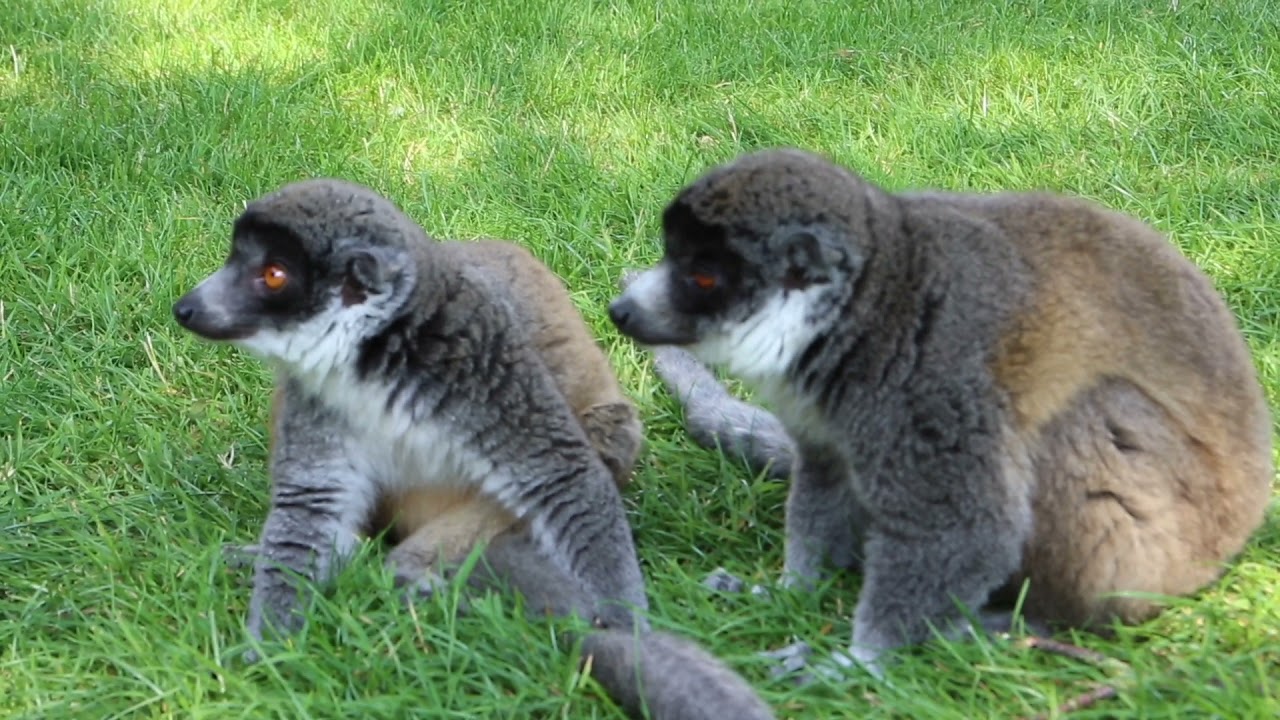Mongoose Lemur
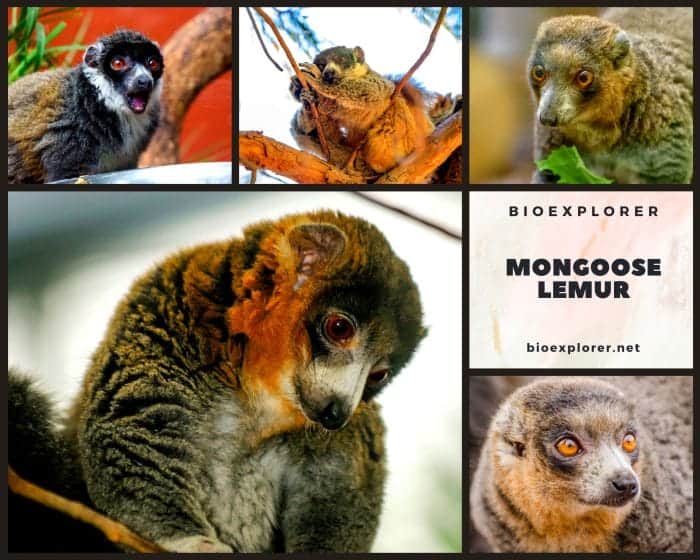
| Kingdom | Class | Order | Family | Phylum | Species |
|---|---|---|---|---|---|
| Animalia | Mammalia | Primates | Lemuridae | Chordata | Eulemur mongoz |
The mongoose lemur (Eulemur mongoz) is a small, endangered primate found only on the African island of Madagascar. With their bushy ringed tails, reddish-brown fur, and white beards on the males, these arboreal creatures play a vital role in dispersing seeds and pollinating flowers in Madagascar’s threatened tropical forests.
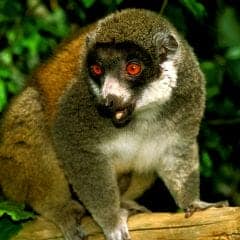

- Common Name: Mongoose Lemur
- Taxonomy Classification Year: 1766
- Monkey Size: 30 to 46 cm (12 to 18 in)
- Skin Color(s): Gray,Black,Brown,White
- Habitat: Forest
- Diet: Herbivorous
- Native Countries: Madagascar
Mongoose Lemur Distribution
Jump to:
Mongoose Lemur’s Physical Characteristics
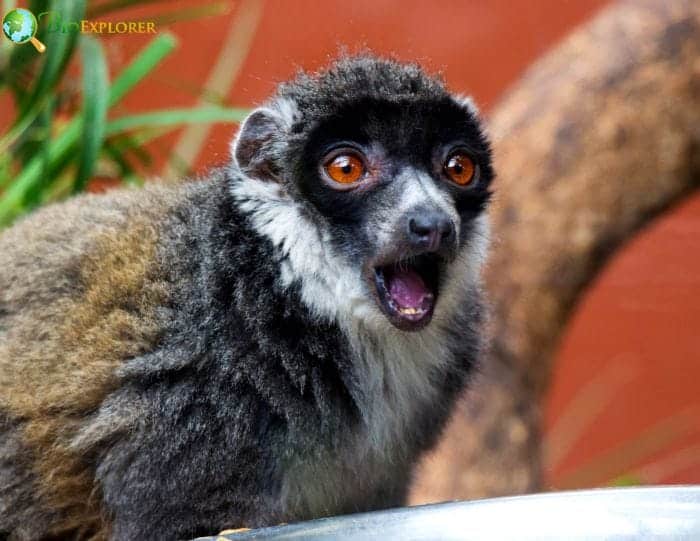
Mongoose Lemurs belong to the lemur family (Lemuridae) and live in small, close-knit family groups consisting of a mated pair and their offspring. They are distinguished by having pointed faces, dark brown fur on the upper body, pale bellies, and long tails that help them balance while leaping through the forest canopy.
Some key facts about mongoose lemurs:
- Size: 12-18 inches long (body), plus a 16–25-inch tail.
- Weight: 4-5 pounds
- Lifespan: Up to 20 years in the wild, 26 years in captivity.
- Habitat: Tropical rainforests in eastern and northwestern Madagascar.
- Diet: Mainly fruit, also nectar, flowers, leaves, seeds.
- Activity Pattern: Diurnal in the wet season, nocturnal in the dry season.
- Group Size: Small family groups of 2-10 individuals.
- Coloration: Mongoose lemurs display distinct sexual dimorphism in their physical appearance. Mongoose lemurs have gray to reddish brown fur covering their upper body and limbs, while their underside is pale in coloration.
Facial Features
- Mongoose lemurs are distinguished by their pointed muzzle and relatively small head. They have short, rounded ears fringed with white fur and small, dark brown eyes.
- The most noticeable facial features are the beards found on both males and females. Male mongoose lemurs have bushy red beards extending from the cheeks and chin, while females sport shorter white beards:
- Males may also develop a bald patch on top of their heads from scent-marking practices.
![]()
Limbs
Mongoose lemurs have long back legs for leaping between branches and short forelimbs for grasping. Their bushy, ringed tails act as a counterbalance when jumping through trees.
![]()
Mongoose Lemur Habitat and Geographical Range
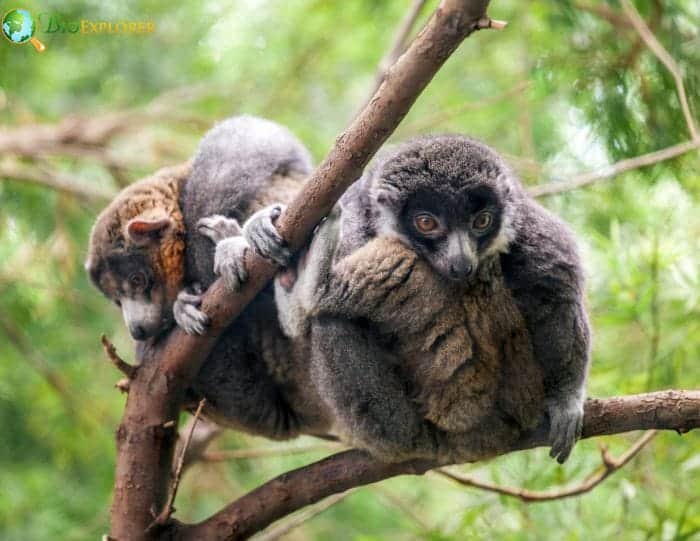
Mongoose lemurs reside in a variety of forest ecosystems on the island of Madagascar, typically found along coastal and riverine areas in the east and northwest[1].
Specific habitats include:
Lowland Rainforests
- Primary habitat
- High canopy trees up to 100 ft tall.
- Ideal fruit productivity supports lemur density.
- Suffer heavy deforestation pressure from logging.
Mid-Altitude Forests
- Broadleaf evergreen forests at 650-1500m elevation.
- Sparser lemur populations but territory richness high.
- Cooler temperatures with frequent rainfall.
Riverine Gallery Forests
- Thin corridors along rivers and streams.
- Rely on waterways as fluid transport pathways.
- Increased foliage during dry winter from river moisture.
Mangrove Forests
- Mix of rainforest trees and coastal mangrove vegetation.
- Periodically swim between close mangrove islets at high tide.
- Forage on tidal mudflats at low tide.
Dry Deciduous Forests
- Transition zone to grassland/savanna biomes.
- Hotter temperatures and prolonged drought.
- High variability in food availability throughout year.
Mongoose lemurs require vertical strata with connected canopy pathways for traversing their home ranges of 50-100 acres. But all of Madagascar’s forests face immense pressure from land conversion, fires, invasive species and other anthropogenic threats. Habitat protection is vital for endangered primates like the mongoose lemur.
They depend on the forest habitat for food, shelter, and raising their offspring. Unfortunately, Madagascar has lost over 80% of its natural forest cover, threatening endemic wildlife like the mongoose lemur.
![]()
What Do Mongoose Lemurs Eat?
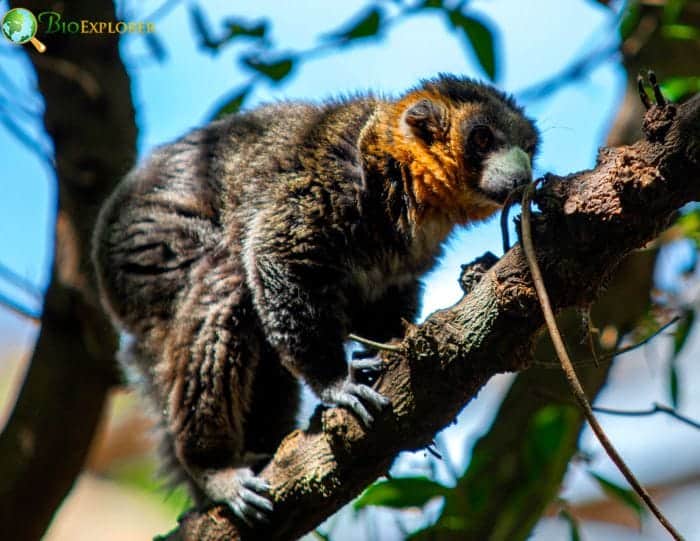
Mongoose lemurs are frugivorous, meaning fruit makes up the majority of their diet. They also supplement their nutritional intake with[2]:
- Nectar
- Flowers
- Leaves
- Seeds
- Mushrooms
The nectar of the kapok tree (Ceiba pentandra) is especially vital, comprising up to 80% of their diet during Madagascar’s long dry season when other resources are scarce.
Mongoose lemurs are important seed dispersers for many rainforest tree species after passing the indigestible seeds. This makes them critical to the regeneration of Madagascar’s forests.
While they get most food high in the treetops, mongoose lemurs occasionally come to the ground to forage as well. Here they’ll eat items like beetle grubs in addition to fallen fruit[3].
![]()
What Eats Mongoose Lemurs?
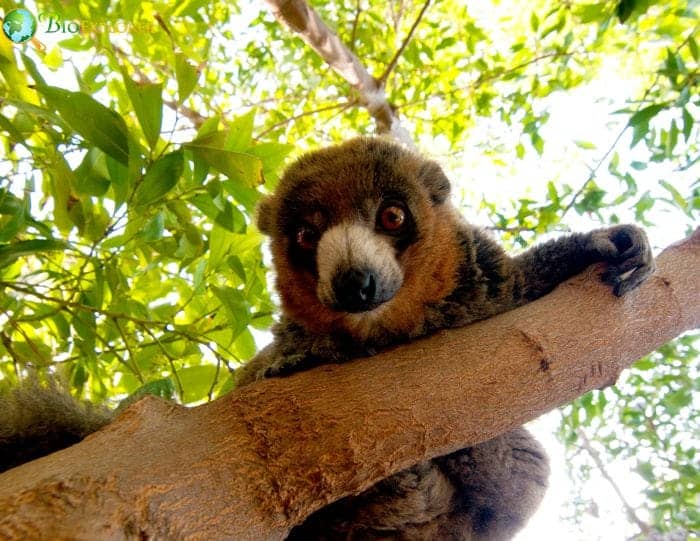
Although nimble and agile in traversing their arboreal habitats, mongoose lemurs face predation pressure from a variety of rainforest carnivores. Their enemies include:
Fossas
- Cat-like mammal native to Madagascar.
- Primary mongoose lemur predators.
- Powerful hunters that prey on small lemurs.
- Threaten young and juveniles in particular.
Raptors
- Birds of prey like harrier-hawks and Madagascar buzzards.
- Strike from air and carry off lemur infants.
- Adults attempt to chase birds away or take cover.
Boa Constrictors
- Introduced snake species on Madagascar.
- Can strike suddenly from branches.
- Constrict lemurs or swallow them whole.
Humans
- Illegal poaching for bushmeat.
- Habitat loss also threatens mongoose lemur survival.
To avoid predators, mongoose lemurs rely on safety in numbers, hiding in dense tangles of vines and branches, nesting high up in emergent trees, and mobbing aerial raptors as a group to drive them away. But continued habitat fragmentation leaves them increasingly vulnerable.
![]()
Mongoose Lemur Behavior and Lifestyle
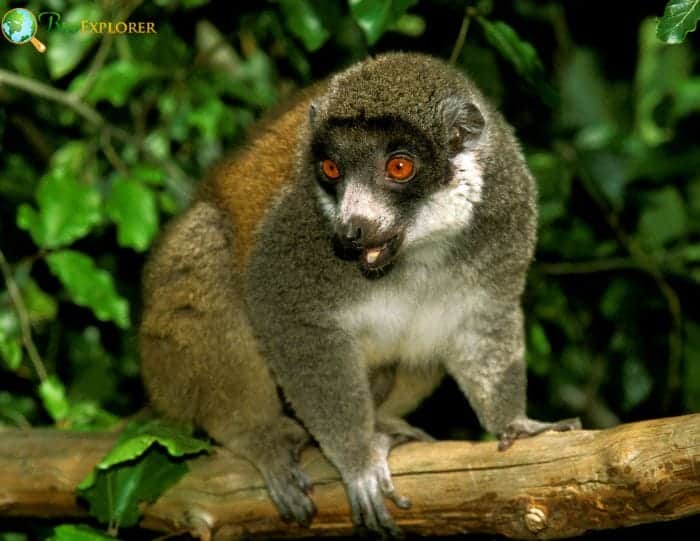
Social Structure
Mongoose lemurs live in small, close-knit family groups typically consisting of:
- A mated male-female pair (the alpha male and female).
- Up to 3 of their offspring from previous years.
The average group size is around 5-6 individuals.
Occasionally young adult males who have left their natal group may join a new family. But mongoose lemur groups rarely interact or encounter each other in their rainforest habitats. When groups do intersect over territory disputes, aggressive behavior often ensues.
![]()
Reproduction and Offspring
Mating occurs over a short period from March-April. After a 120-day gestation, females give birth to a single infant. Babies are born in August to October, right before Madagascar’s rainy season when food will be plentiful.
Young mongoose lemurs:
- Weigh around 3-4 oz at birth.
- Are weaned at 5 months old.
- Reach maturity at 3 years old.
Male offspring usually disperse from the family group upon maturity at around 3 years old. Females may remain behind to inherit breeding status.
![]()
Activity Cycles
Mongoose lemurs demonstrate cathemeral activity patterns, meaning they are active sporadically throughout the 24-hour daily cycle. Their foraging and social behavior shifts between day and night depending on external seasons:
Wet Season (November-March)
During Madagascar’s rainy season with plentiful food and moderate temperatures, mongoose lemurs are mostly diurnal with activity concentrated in daylight hours:
- Wake up just after dawn.
- Communal morning grooming sessions strengthening social bonds.
- Forage for fruit and flowers in the high canopy till mid-afternoon.
- Take midday rest while digesting and shelter from heat.
- Afternoon social play like wrestling or chase games.
- Return to sleeping trees 2 hours before sunset.
Dry Season (April-October)
In the hot, arid dry winter with little rain and food scarcity stress, mongoose lemurs adapt their schedule to become more nocturnal:
- Sleep in protected tree hollows during the sweltering afternoon.
- Wake up after sunset when temperatures start dropping.
- Primarily solitary foraging under the cover of darkness.
- Drink water collected in tree hollows and lick dew from leaves.
- Sleep during the day while sheltering from sun and heat.
- Sync activity with the nocturnal grey mouse lemur during this time.
This seasonal shift in activity patterns allows mongoose lemurs to avoid daytime heat stress, regulate hydration, and conserve energy when resources are limited in winter months. It also reduces competition with other primates occupying the forests. Their cathemeral flexibility suits the extreme shifts in Madagascar’s climate.
Monitoring mongoose lemur chronobiology through advanced radio-collar studies will provide key insights on their behavioral ecology. This data further aids conservation management initiatives aimed at preserving vulnerable endemic species.
![]()
Conservation Status and Threats
Mongoose lemurs are classified as Critically Endangered by the International Union for Conservation of Nature (IUCN[4]) Red List, with wild populations declining severely since the year 2000.
Major threats to mongoose lemur survival include:
Habitat Loss
- Over 80% forest loss in Madagascar over 50 years.
- Remaining forest fragmented and degraded.
- Drought and climate change impacts.
Hunting
- Lemurs hunted as bushmeat or for traditional rituals.
- Lack of local taboos against eating lemurs.
Pet Trade
- Young poached from wild to sell in illegal exotic pet trade.
- No regulation or management of trade levels.
Exact mongoose lemur population sizes are unknown, but likely less than 10, 000 mature individuals left in the wild. Their extinction risk remains extremely high without expanded conservation measures. Protecting remaining forest habitats and limiting illegal poaching are key.
![]()
Fun Facts About Mongoose Lemurs
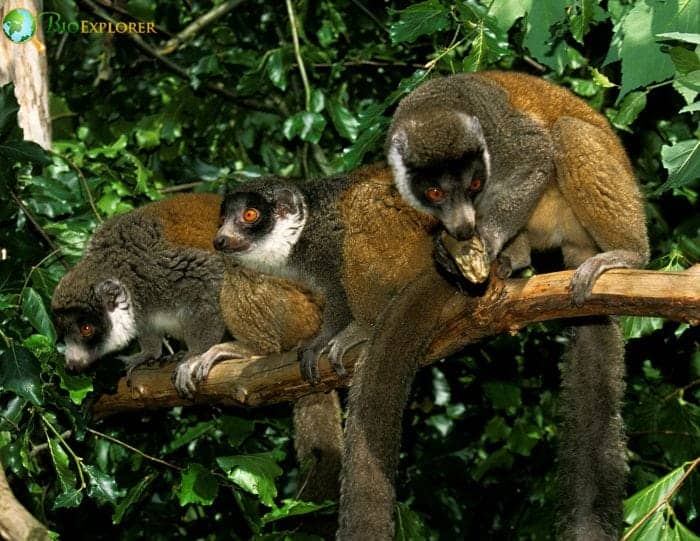
While serious about their survival, here are some delightful things that make the mongoose lemur special:
- Mongoose-Like Faces: Mongoose lemurs get their name from having elongated, pointed faces and long snouts resembling small mongooses. This distinguishes them from more round-faced lemurs.
- Introduced Population: Mongoose lemurs are the only lemurs found outside of Madagascar, having been introduced to the Comoros islands in modern times. A small population thrives on these islands between Africa and Madagascar.
- Stink Fighting Displays: Family groups engage in “stink fights” to establish territorial boundaries. Like sumo wrestling, males rub scent glands on tails and wrists before facing off whilst making aggressive cries at adversaries. The most dominant male wins the smelly match!
- Food Calls: Mongoose lemur groups each have their own unique food call vocalizations used to summon group members to a tasty feeding tree. Scientists can even identify different mongoose lemur families by acoustic analysis of these food calls.
- Baby Back Rides: Newborn mongoose lemurs have a strong grip reflex and will cling to their mothers’ backs constantly for the first few months for transportation and protection. By two months old they start to explore independently.
- Predator Tail Signals: Male mongoose lemurs will wave their long, bushy tails slowly from side to side to signal group members that predators like fossas (a cat-like mammal) or aerial raptors are nearby, alerting them to take cover.
- Sunbathing: On chilly winter days in Madagascar, mongoose lemurs will sprawl out on branches to bask in sunlight. Arms and legs extended sideways or upright; they soak up warmth through the fur on their black bellies.
- Bug Perfume: Strange but true mongoose lemurs will chew on millipedes until they secrete defensive acidic chemicals, then rub the bugs all over their fur like perfume! Scientists guess it could deter ticks and other ectoparasites, but the reason is still a mystery.
- Heat Dissipation: Mongoose lemurs rely on their giant ears to dissipate body heat, an adaptation for nocturnal activity during very hot dry seasons. More veins and blood vessels in ears release heat buildup.
- Daredevil Leaping: Thanks to powerful hind legs containing massive thigh muscles, mongoose lemurs can leap over 33 feet between trees, using their tails as a rudder to steer midair! This is over 6 times their body length. Parkour lemur style!
- Tiniest Eulemur
- Mongoose lemurs are the smallest species among their Eulemur genus, which includes 5 types of brown lemur. Adults reach just over 1-foot-long plus tail, weighing only 4-5 lbs fully grown. They use their petite size to nimbly leap through dense rainforest trees.
- Offspring Dispersal: Both male and female infant mongoose lemurs are forced to leave their natal family group forever when they reach full maturity between 2.5-3.5 years old. This avoids inbreeding and reduces competition for mates and resources like fruit. The adolescent lemurs must venture off to find and join new groups.
- Enhanced Senses: Mongoose lemurs have excellent stereo vision and depth perception thanks to wide-set eyes located frontally on their face. Their sensitive nose has a rhinarium with specialized skin and scent glands to facilitate olfactory communication and scent-marking behaviors.
- Seasonal Activity Switch: Come the cold dry winter, mongoose lemurs will switch their activity from being diurnal to becoming fully nocturnal. They sleep in tree holes during blistering daylight hours, then emerge at nightfall when its cooler to hunt insects and collect water sources like dew droplets from leaves.
- Female Dominance: In mongoose lemur social groups, females are the dominant gender, having priority access to the best sunning spots, first rights to feed on ripe fruit trees, and primary choice of breeding partners. Males show submissive behaviors like teeth-chattering when approaching dominant females.
The adorable mongoose lemur faces an uncertain future as Madagascar’s tropical rainforests continue to vanish. But by supporting conservation groups and ecotourism initiatives, we can help ensure this acrobatic, seed-dispersing primate persists for generations to come.
Cite this page
Bio Explorer. (2025, December 31). Mongoose Lemur. https://www.bioexplorer.net/animals/mammals/prosimians/mongoose-lemur/

